 United Kingdom (1896-1921)
United Kingdom (1896-1921)C class: 3 ships: HMLS Albatross, Express, Arab
WW1 British Destroyers:
26 knotters | 27 knotters | 30 knotters | 33 knotters | Turbine destroyers | River class | Cricket class | Tribal class | Beagle class | Acorn class | Acheron class | Acasta class | L class | M class | Repeat M class | Medea class | Faulknor class FL | Marksman class FL | Parker class FL | Talisman class | Shakespeare class FL | R class | S class | Repeat R class | V class FL | Scott class FL | V class | W classDevelopment
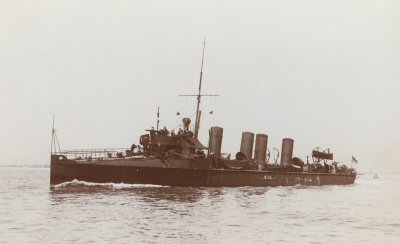 At the end of the process of ordering faster and faster “torpedo boat destroyers” the admiralty was found in a predicament, as the technology behind vertical triple expansion engines seemingly had reach its limits. Yet, Various yards affirmed they could achieve speed beyond 30 knots and various proposals were made, like adding a pair of boilers and stretching the hull mid-section of existing designs, or used a larger, more efficient VTE steam engine, working on the propellers shapes and size, on the underbelly stern shape and refining hull line entries.
At the end of the process of ordering faster and faster “torpedo boat destroyers” the admiralty was found in a predicament, as the technology behind vertical triple expansion engines seemingly had reach its limits. Yet, Various yards affirmed they could achieve speed beyond 30 knots and various proposals were made, like adding a pair of boilers and stretching the hull mid-section of existing designs, or used a larger, more efficient VTE steam engine, working on the propellers shapes and size, on the underbelly stern shape and refining hull line entries.
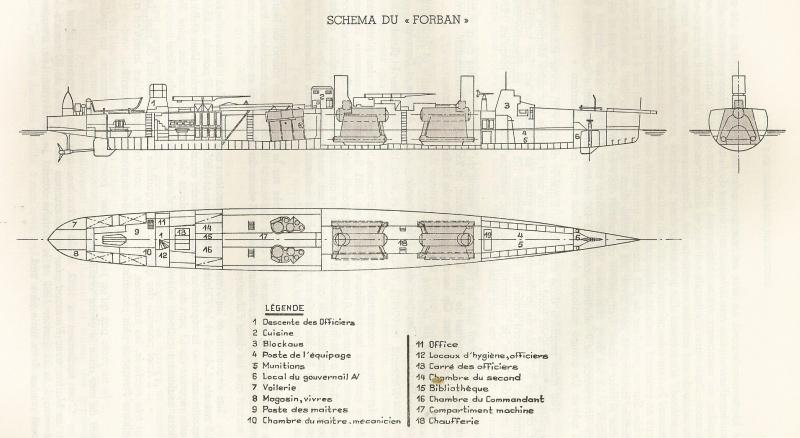
Motivation: Plan of the 31 knots 1895 Forban
As the “30 knotters” orders were passed, the admiralty after the incremental series of 26 and 27 knotters, were convinced that faster destroyers were possible, ordered three more “specials” to selected yards. In that occurrence, three, one of each yard, Thornycroft, Laird and Thomson were ordered as part of the 1896-97 plan. Note that more 30-knotters were ordered in 1899 as the “33 knotters” were found unable to reach this speed precisely. However with hindsight this could not be known. This requirement for 33 knots did not came out the blue through, as the Admiratly justy learned about the 31-knot capable French high seas torpedo boats of the Forban class. The latter was trialled in 1895 and the French published that speed, unprecedented at the time.
The 33 knots limit seemed a reasonable increase given what was affirmed by these yards after an enquiry. But none reached this desrired figure. They managed between 30 and 31.5 knots at best on trials. At least they had the merit to prove that reaching 33 knots with a triple expansion engine was seemingly impossible, at least without considerable, lenghtly and costly improvements.
Indeed even by stretching designs to add extra boiler power, the overall extra displacement would cripple the efforts. No amount of pressure could turn the shafts fast enough without endangering the whole ship. It was avoided to push for example the boilers beyond their maximal theoretical limits as metallurgy was still progressing, advanced casting techniques at the time were still far from perfect.
Nevertheless, Thornycroft delivered HMS Albatross, Laird HMS Express and Thomson HMS Arab in July 1900, February and January 1902 for the two others. They were large for destroyers, reaching 500 tons fully loaded for the first time.
Design
Hull and general design

The general design was similar to 30-knotters, the only difference being in size. Previous destroyers were in the 320-380 tonnes range, 215-220 feet long (60+ meters) and a tenth in beam. Albatross, Express and Arab shared the same flush deck with raised stem, turtleback forward of the conning tower protecting the steering wheel, with a platform supporitng the main gun above, wrapped in canvas. The flat deck beyong the bulkwark protecting lighter guns. The exact same armament was kept as the 30 knotters. The hulls were just longer, costier, just as their machinery. Being from different yards they came out with three different designs as well (specs later). Thornycroft’s Albatross (best of the three) had three funnels, Laird’s Express had four, and HMS Arab from Thomson had four, but unheavenly spaced (see later).
Powerplant
This of course diverged between ships. HMS Albatross had two four-cylinder Vertical Triple Expansion engines (VTE) fed by four Thornycroft boilers. This gave her a 7,500 shp rating.
HMS express had two four-cylinder VTE fed by four Normand boilers and said to be the best for output, reporting the unprecedented figure of 9,250 shp. HMS Arab had about the same powerplant, same Normand boilers but was rated for 8,600 shp. This was still enormous compared to previous 30-knotters, which as standard reached at best 6000 ihp.
On trials, they disappointed, although the admiralty recoignised itself the goal was perhaps too ambitious. Despite having the least output of the three, HMS Albatross reached 31.5 knots on trials, whereas Express reached 31 knots and Arab reached 30 knots. Most of the 30 knotters rarely reached that speed anyway, but for their additional cost, the gain was negligible.
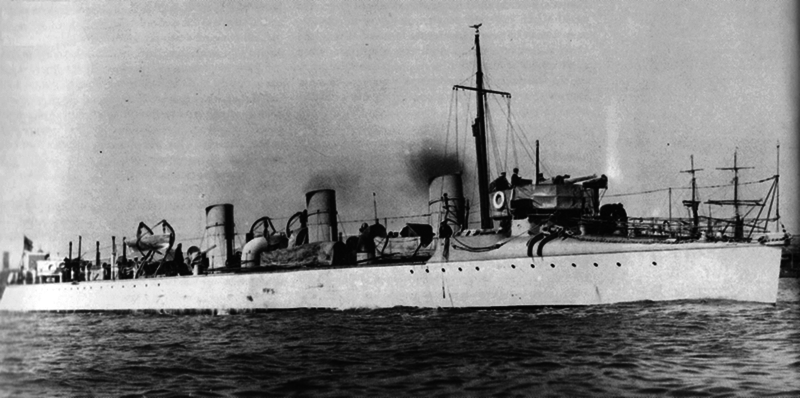
As for range, they carried between 105 and 130t coal for 3000 nautical miles at ten knots cruise speed. As for all previous series, they sat low on water and therefore, on heavy weather or even slightly choppy seas, they suffered much from sea spray, considered very wet at all times, plus speed degraded rapidly. They arrived with the last flusg deck destroyers of the RN, the other “specials” ordered after the major stunt by Turbinia in 1897. The turbine powered HMS Viper (first to reach 33 knots), Cobra (30 kts) and the composite Velox (22 kts).
The consideration in 1900 was that the only way to keep speed in the usual north sea weather was to adopt a forecatle for destroyer, something new at the time. Palmer Yard was a pioneer for this, with the Erne class, forst of the “River” class destroyers, next generation and often considered the first true Britush destroyers.
Armament
Main: QF 12-pounder 12 cwt naval gun
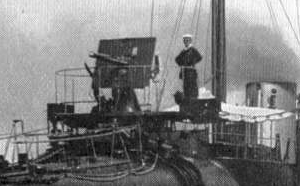 The QF 12-pounder 12 cwt naval gun was brand new when the 26-knotters were in construction, enterering service in 1894. placed on a raised platform overlooking the foredeck, and generally behind a platform protected by canvas. This 0.6 tons (510 kg) ordnance made a superb career going up to 1945, with more than 8,000 delivered. It was also used by Italy and Japan and became the staple of light artillery on most RN ships, especially those of WW1. In the case of these destroyers, the Mark I was shielded and placed on the conning tower platform, high enough to avoid water spray. But in heavy weather, as the ship were ploughing deep due to their turtleback, they were wet anyway.
The QF 12-pounder 12 cwt naval gun was brand new when the 26-knotters were in construction, enterering service in 1894. placed on a raised platform overlooking the foredeck, and generally behind a platform protected by canvas. This 0.6 tons (510 kg) ordnance made a superb career going up to 1945, with more than 8,000 delivered. It was also used by Italy and Japan and became the staple of light artillery on most RN ships, especially those of WW1. In the case of these destroyers, the Mark I was shielded and placed on the conning tower platform, high enough to avoid water spray. But in heavy weather, as the ship were ploughing deep due to their turtleback, they were wet anyway.
Specs:
It used a Separate-loading QF round, caliber 7.62 cm, with a single-motion screw breech.
Rate of fire was 15 rounds per minute, at 2,210 ft/s (670 m/s) for an effective range of 11,750 yd (10,740 m) at 40° for the latter version.
Secondary: 3-5 QF 6-pdr Hotchkiss
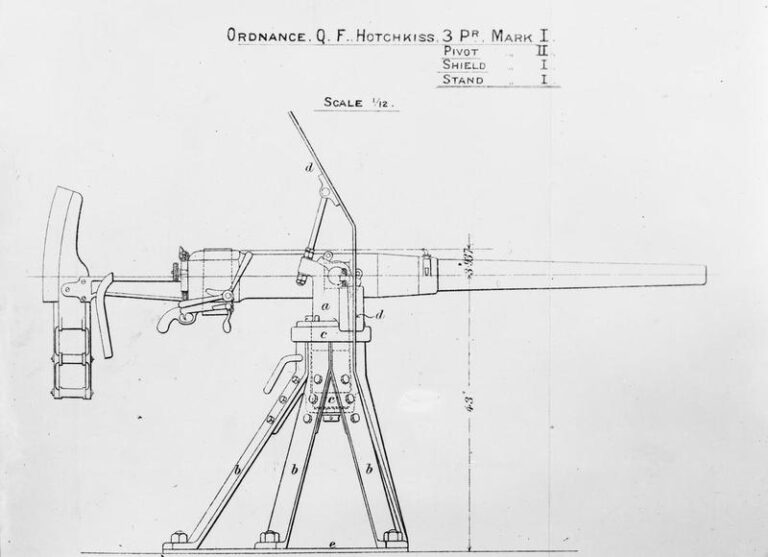
This “classic among classic” was developed in 1883 by Hotchkiss et Cie and a licenced was acquired by Elswick in Britain for mass manufacturing. It became the go-to light QF gun, still very much in favor by the 1890s. Weighting around 821–849 lb (372–385 kg) and shielded, the three guns were located forward for the first pair, abreast the main 12-pdr behind bulwark (but they were wet also) and the third was located on an axial platform aft, close to the stern.
Later in the early 1900s the side TTs were removed and replaced by two more, also shielded, placed on sponsoned platforms for a better arc of fire forward and aft.
Together with the 3-in gun (12 pdr) they could send 140 rounds every minute at the infortunate TB that could cross their path. They generally replaced the dismoured bow tube (not installed on the bulk of the 27 knotters).
Specs:
57x307R 57-millimetre (2.244 in), Vertical sliding-block breech, 4 inch hydro-spring recoil
Rate of fire 25/minute at 1,818 feet per second (554 m/s), range 4,000 yards (3,700 m)
Torpedo Tubes
The Type used was likely the 18-inches Whitehead (45 cm) type, developed in 1888, and introduced as the 26-27 knotters were completed in 1894:
They weighted 845 lbs. (383 kg) for 140 in (3.556 m) in length, with an explosive charge of 118 lbs. (53.5 kg) using wet gun-cotton, single setting, 800 yards (730 m) at 26.5 knots (which was actually slower than the destroyer’s top speed!). It was driven by a three cylinder radial Brotherhood pattern engine, fed by an Air-flask (cold running) of compressed air.
No upgrade as they were ultimately all retired. Outside the bow tube, the two other ones were axial, located aft, often before the aftermost funnel and close to the aft steering post and before the stern gun. Six torpedoes were carried, the three already in the tubes, and three spares.
 HMS Albatross (1900)
HMS Albatross (1900)

Thornycroft 33-knots “special” destroyer HMS ALBATROSS was oprdered as part of the 1896-97 programme at Yard 318 of Thornycroft, Chiswick. She was laid down on 27.11.1896, launched on 19.7.1898 and completed in July 1900. She spent the first years in never-ending, vain running acceptance trialsn testing various propeller shapes, or rudders, in a vain attempt to reach 33kts and only Albatross came close. After final acceptance the admiralty realized the cost overall of thes “specials” made them rather more expensive for “30-knotters” and failing to achieve their goal, they were assimilated into the “C” class in 1912 as early destroyers were reorganized in a more sensible way. HMS Albatross still appeared the most successful of these three vessels, achieving more on less power than the others but her builders wasted a long time, time, from October 1898 to July 1900 trying to reach the intended speed, as much as she was delayed by labour strikes. In the end HMS Albatross appeared as the most expensive destroyer the company ever made and she was distnctinve by her three heavenly spaced funnels.
After her commissioning she was assigned to the British Mediterranean Flee (Lt. Cdr H.P. Buckle). By early January 1901 she was back in Home waters entering the Medway instructional flotilla. Paid off at Chatham on 29 August 1901 she had a first machinery overhaul. Her crew was transferred to the destroyer Chamois back in the Mediterranean Fleet. Commander Edwyn Alexander-Sinclair took command when she was re-commissioned on 24 February 1902 for new sea trials, and she failed to reach even 31 knots. She spent time as tender to Pembroke Chatham shore establishment and departed for the Mediterranean by late May 1902, Malta in June. September 1902 saw her cruising the Aegean Sea for combined manoeuvres near Nauplia. By January 1903 the same happends, this time off Corfu. She was back home in 1913, reclassified in C class, assigned to the 7th Destroyer Flotilla, Devonport.
She had the letter ‘C’ painted on her hull below the bridge and fore or aft funnel.
In July 1914 she was still with the 7th Destroyer Flotilla with the destroyer depot ship HMS Leander. In September 1914, her unit was redeployed to the Humbe Patrol and she multiplied ASW and counter-mining patrols until 1916, then joined the home defence flotilla of Scapa Flow, still provding anti-submarine patrols.
In 1919 she entered the reserve and was stricken, sold on 7 June 1920 to J.W. Houston, Montrose, BU. She sported the pennants D32 in 1914-15, D44 in 1915-18 and D02 until her retirement.
⚙ specifications (Albatross) |
|
| Displacement | 430t standard, 490t fully loaded |
| Dimensions | 69.2 oa/68.6 pp x 6.49 x 2.77m |
| Propulsion | 2x 4-cyl VTE, 4 Thornycroft boilers 7,500 shp |
| Speed | 31.5 knots trials |
| Range | coal 105 tons, 3000 nm at 10 kts |
| Armament | 1x 12pdr or 3-in (76mm/40) or 12cwt QF Mk I, 5x 6 pdr (57mm/40) Hotchkiss Mk I, 2x 450mm TT (4) |
| Crew | 69 |
 HMS Express (1902)
HMS Express (1902)
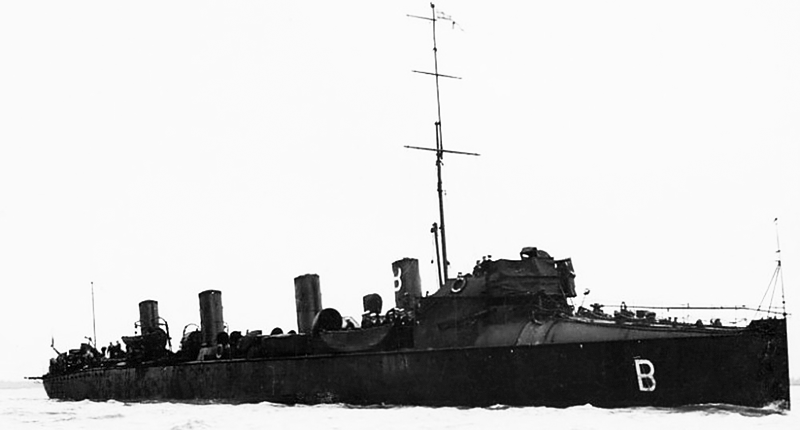
HMS Express was ordered in 1896, laid down at Yard 629 in Laird, Birkenhead on December 1896, launched on 11 December 1897 but only completed in February 1902. She collided with the stores ship RFA Aquarius by December 1907 at Lamlash in Scotland. In 1909 she belonged to the 5th Destroyer Flotilla in Devonport until 1912. On 30 August 1912 she was reclassed in the B class as qhe sported four funnels. She was assigned to the 7th Flotilla at Devonport. On 8 May 1913, she collided with the British merchant Leicester in dock at Grimsby. She left the 7th Flotilla by November 1913, placed in reseve until January 1914, retransferred to the 8hth Flotilla at Chatham, then the Forth Estuary. She had a long refit in January 1917 and by June joined the East Coast Convoy Flotilla in the Humber, then 7th Flotilla in July. In Decembe she joined the Northern Division, Larne (Ireland Station). She patrolled the North Channel between Scotland and northern Ireland until the end of the war. She was stricken by December 1919 and sold to G Clarkson of Whitby on 17 March 1920.
⚙ specifications (Albatross) |
|
| Displacement | 465t standard, 540t fully loaded |
| Dimensions | 73 oa x 7.22 x 3.12m |
| Propulsion | 2x 4-cyl VTE, 4 Normand boilers 9,250 shp |
| Speed | 31 knots trials |
| Range | coal 130 tons, 3000 nm at 10 kts |
| Armament | 1x 12pdr or 3-in (76mm/40) or 12cwt QF Mk I, 5x 6 pdr (57mm/40) Hotchkiss Mk I, 2x 450mm TT (4) |
| Crew | 74 |
 HMS Arab (1903)
HMS Arab (1903)
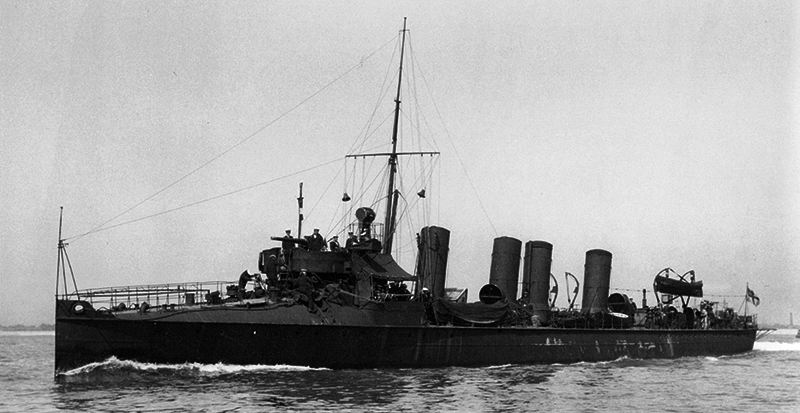
This Thomson 33-knots “special” was ordered also in 1896 but she was the last completed. Built at Thomson, Clydebank, laid down in March 1900 she was launched in Febriuary 1902 and completed in January 1903 but delayed notably to reach her expected speed, before commission.
HMS Arab stayed in home waters, started service at Portsmouth under Captain Cdr. Hubert Brand from 12 January 1903, replacing HMS Success as senior officer’s ship in the Instructional Flotilla. Refitted in 1908 (boilers retubed) she was in 1910 reassigned to the 5th Destroyer Flotilla, Devonport until 1912. On 30 August saw her reclass as the B class and in March 1913 she joined the 7th Destroyer Flotilla. In WWI she is sent to the East coast of England and by November transferred to Scapa Flow among 29 destroyers patrolling around the base.
In April 1917, U-30 was signalled attacking shipping between Bergen and Lerwick, claiming six ships on 13-14 April, and HMS Arab was sent to escort the merchant ship SS Rondane when attacked off Fjeldi, she spotted, fired on U-30, forced to submerge. On 7 July 1917 she escorted a convoy to Norway when signalled the yacht Amalthaea and whaler Pilot Whale spotted and fired on an other U-Boat, and Arab rushed out, dropping depth charges and driving it away. On 19 July 1917 with HMS Sarpedon on the same Lerwick–Norway route, she missed the U-67 but rescued the crew of Danish steamer Harrildsborg, just sank.
By January 1918 she was retransferred to the Firth of Forth, Methil Convoy Flotilla and in May returned to the 7th Flotilla on the Humber, and until V-Day. She wwas placed in reserve and sold for BU in July 1919.
⚙ specifications (Arab) |
|
| Displacement | 470t standard, 530t FL |
| Dimensions | 70.7 x 6.78 x 2.97 |
| Propulsion | 2x 4-cyl VTE, 4 Normand boilers 8,600 shp |
| Speed | 30.7 knots trials |
| Range | coal 109 tons, 3000 nm at 10 kts |
| Armament | 1x 12pdr or 3-in (76mm/40) or 12cwt QF Mk I, 5x 6 pdr (57mm/40) Hotchkiss Mk I, 2x 450mm TT (4) |
| Crew | 69 |
Read More/Src
Books
Chesneau, Roger & Kolesnik, Eugene M., eds. (1979). Conway’s All The World’s Fighting Ships 1860–1905. London: Conway Maritime Press.
Gardiner, Robert & Gray, Randal, eds. (1985). Conway’s All The World’s Fighting Ships 1906–1921. Conway Maritime Press.
Colledge, J. J.; Warlow, Ben (2006) [1969]. Ships of the Royal Navy: The Complete Record. Chatham Publishing.
Dittmar, F.J.; Colledge, J.J. (1972). British Warships 1914–1919. Shepperton, UK: Ian Allan.
Friedman, Norman (2009). British Destroyers: From Earliest Days to the Second World War. Barnsley, UK: Seaforth Publishing. ISBN 978-1-84832-049-9.
Lyon, David (2001) [1996]. The First Destroyers. London: Caxton Editions.
Manning, T. D. (1961). The British Destroyer. London: Putnam & Co.
March, Edgar J. (1966). British Destroyers: A History of Development, 1892–1953. Official Records & Returns. London: Seeley Service.
Links
digital.nls.uk british-military-lists
http://www.rmg.co.uk Warship Histories Vessels
naval-history.net/ BritishShips-Locations
digital.nls.uk/ british-military-lists/
naval-history.net/ BritishShips-Locations
naval-history.net/ BritishShips-Locations
naval-history.net BritishShips-Locations
navypedia.org uk_torpedoships.htm
wiki/HMS_Express
wiki/HMS_Arab

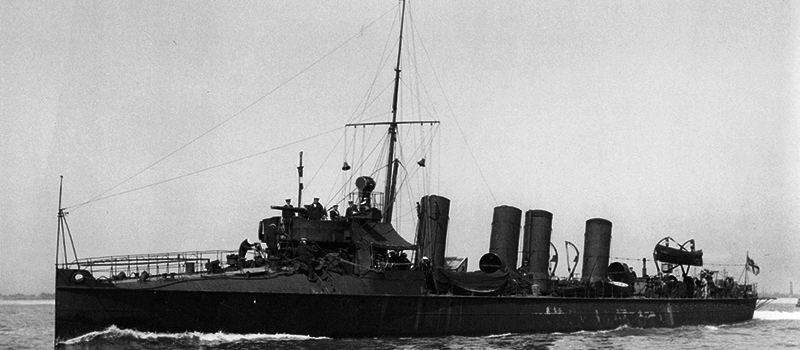
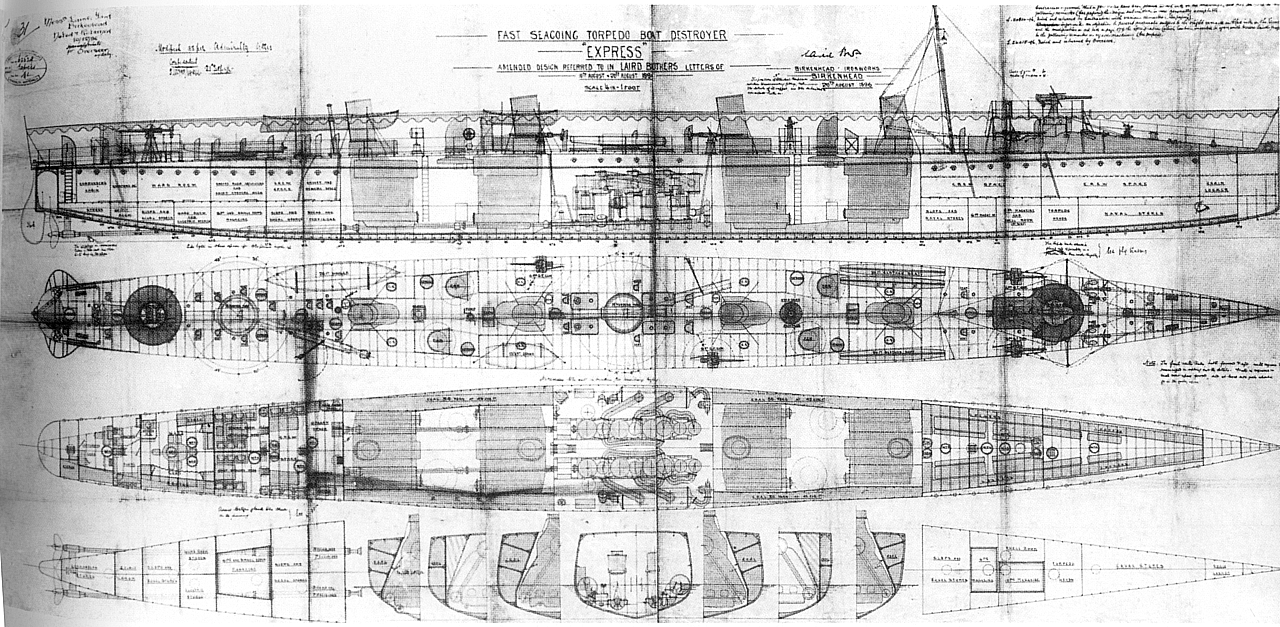
 Latest Facebook Entry -
Latest Facebook Entry -  X(Tweeter) Naval Encyclopedia's deck archive
X(Tweeter) Naval Encyclopedia's deck archive Instagram (@navalencyc)
Instagram (@navalencyc)





 French Navy
French Navy Royal Navy
Royal Navy Russian Navy
Russian Navy Armada Espanola
Armada Espanola Austrian Navy
Austrian Navy K.u.K. Kriegsmarine
K.u.K. Kriegsmarine Dansk Marine
Dansk Marine Nautiko Hellenon
Nautiko Hellenon Koninklije Marine 1870
Koninklije Marine 1870 Marinha do Brasil
Marinha do Brasil Osmanlı Donanması
Osmanlı Donanması Marina Do Peru
Marina Do Peru Marinha do Portugal
Marinha do Portugal Regia Marina 1870
Regia Marina 1870 Nihhon Kaigun 1870
Nihhon Kaigun 1870 Preußische Marine 1870
Preußische Marine 1870 Russkiy Flot 1870
Russkiy Flot 1870 Svenska marinen
Svenska marinen Søværnet
Søværnet Union Navy
Union Navy Confederate Navy
Confederate Navy Armada de Argentina
Armada de Argentina Imperial Chinese Navy
Imperial Chinese Navy Marinha do Portugal
Marinha do Portugal Mexico
Mexico Kaiserliche Marine
Kaiserliche Marine 1898 US Navy
1898 US Navy Sovietskiy Flot
Sovietskiy Flot Royal Canadian Navy
Royal Canadian Navy Royal Australian Navy
Royal Australian Navy RNZN Fleet
RNZN Fleet Chinese Navy 1937
Chinese Navy 1937 Kriegsmarine
Kriegsmarine Chilean Navy
Chilean Navy Danish Navy
Danish Navy Finnish Navy
Finnish Navy Hellenic Navy
Hellenic Navy Polish Navy
Polish Navy Romanian Navy
Romanian Navy Turkish Navy
Turkish Navy Royal Yugoslav Navy
Royal Yugoslav Navy Royal Thai Navy
Royal Thai Navy Minor Navies
Minor Navies Albania
Albania Austria
Austria Belgium
Belgium Columbia
Columbia Costa Rica
Costa Rica Cuba
Cuba Czechoslovakia
Czechoslovakia Dominican Republic
Dominican Republic Haiti
Haiti Hungary
Hungary Honduras
Honduras Estonia
Estonia Iceland
Iceland Eire
Eire Equador
Equador Iran
Iran Iraq
Iraq Latvia
Latvia Liberia
Liberia Lithuania
Lithuania Mandchukuo
Mandchukuo Morocco
Morocco Nicaragua
Nicaragua Persia
Persia San Salvador
San Salvador Sarawak
Sarawak Uruguay
Uruguay Venezuela
Venezuela Zanzibar
Zanzibar Warsaw Pact Navies
Warsaw Pact Navies Bulgaria
Bulgaria Hungary
Hungary

 Bundesmarine
Bundesmarine Dutch Navy
Dutch Navy Hellenic Navy
Hellenic Navy Marina Militare
Marina Militare Yugoslav Navy
Yugoslav Navy Chinese Navy
Chinese Navy Indian Navy
Indian Navy Indonesian Navy
Indonesian Navy JMSDF
JMSDF North Korean Navy
North Korean Navy Pakistani Navy
Pakistani Navy Philippines Navy
Philippines Navy ROKN
ROKN Rep. of Singapore Navy
Rep. of Singapore Navy Taiwanese Navy
Taiwanese Navy IDF Navy
IDF Navy Saudi Navy
Saudi Navy Royal New Zealand Navy
Royal New Zealand Navy Egyptian Navy
Egyptian Navy South African Navy
South African Navy






























 Ukrainian Navy
Ukrainian Navy dbodesign
dbodesign